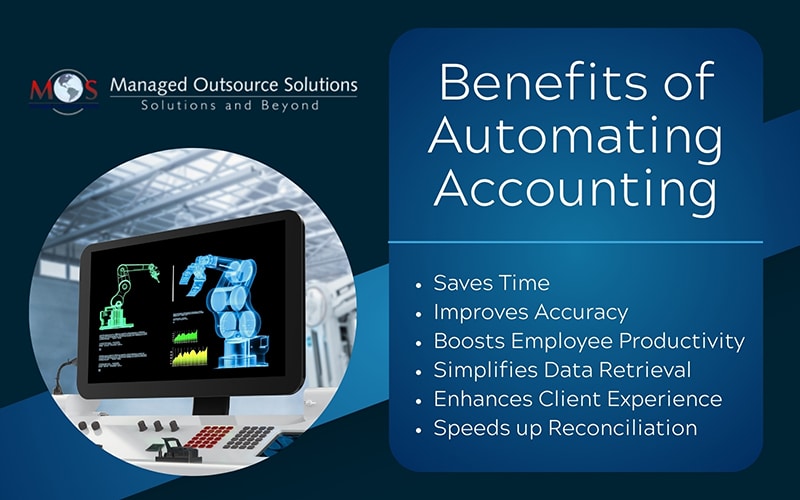Accounting errors that occur when recording financial transactions can significantly affect a business. These mistakes lead to inaccurate financial statements, poor decision-making, lost investor confidence, potential legal and reputational damage, and missed business opportunities. Mistakes made when recording, calculating, or reporting financial transactions usually occur due to human error. If your business is experiencing such accounting errors, it’s time to consider automation. Robotic Process Automation (RPA) is transforming accounting by automating repetitive tasks, improving accuracy, and freeing up staff to focus on other core activities. This post discusses 8 essential accounting tasks to automate for improving accuracy and compliance.
What is Accounting Automation and Why is it Important?
Accounting automation utilizes software and AI to automate various processes that were traditionally done manually. This includes tasks like data entry, invoicing, payments, financial reporting, and reconciliations. RPA reduces manual accounting work and risk of errors, improves accuracy and enhances efficiency in managing financial processes.
The ability of automation to reduce accounting mistakes is important given that a recent Gartner survey showed that 59% of accountants make “several errors per month”. Also, 18% of accountants surveyed reported making financial mistakes daily. These errors can range from simple data entry mistakes, omissions, and duplication to more complex issues like misclassifying expenses, misapplications of accounting principles, or failing to reconcile accounts.
By leveraging automation and technology, accountants can overcome traditional limitations, promoting accurate, efficient, and proactive financial management. Automation boosts accountants’ productivity by removing repetitive, error-prone tasks that slow them down each day. According to Gartner Research, “finance departments can save their teams 25,000 hours of avoidable rework caused by human errors by deploying Robotic Process Automation (RPA) in their financial reporting processes. In fact, the addition of automation in finance teams can save approximately 30% of a full-time employee’s day.”
Eight Key Accountancy Tasks to Automate Today
Here are the top accountancy tasks you should automate now:
Bookkeeping
Bookkeeping involves systematic data entry to record, organize, and maintain a detailed record of all financial transactions. Efficient bookkeeping ensures that all your financial transactions, such as sales, purchases, receipts, and payments, are accurate, clear, and organized in a structured manner.
However, data entry is one of the most tedious, time-consuming, and error-prone tasks in accounting. That’s why bookkeeping should be the first task to automate. With bookkeeping automation, you can automate data entry and enhance accuracy. Bots have the ability to capture and interpret data, automatically validating figures against predefined criteria. RPA generates reliable and consistent financial reports, while significantly reducing the time spent on data entry.
Invoicing
Like bookkeeping, invoicing involves manual input of details like customer information, itemized list of goods or services, pricing, and payment terms. Filling out spreadsheets or word processing templates by hand with the details of transactions offers flexibility, it is time-consuming and prone to errors. This makes invoicing an ideal candidate for automation.
Automating invoicing with cloud accounting software will ensure that data is automatically recognized and uploaded to the accounting system. It will integrate invoicing software, allowing you to easily create, edit invoices that the system emails out, monitor whether or not the invoices have been paid, and issue reminders on your behalf. Automatic invoice recognition tools that integrate with accounting software make invoice processing easier, faster, and more accurate—reducing time spent on data entry and minimizing the risk of typos.
Reconciliation
Reconciling accounts is crucial for maintaining the integrity of financial data and ensuring the accuracy of financial statements. Checking if your records align with the transactions in your bank accounts and sales channels. The process, which consumes a significant amount of time, should be done at least once a month.
Automated reconciliation uses software to automatically import and match financial records from different sources like bank statements, credit card transactions, and internal accounting records. The software can identify discrepancies and ensure accuracy, while significantly reducing the time and effort required for manual reconciliation.
Expenses
Are you fed up with piles of paper receipts swamping your desk? Then implement a digital expense tracking service that integrates seamlessly with major accounting software. This automation solution scans receipts and extracts key information. The captured data is then uploaded directly into your accounting system in a structured, user-friendly format, enabling real-time reconciliation. Accounts payable automation streamlines the entire invoice-to-payment process, reducing manual data entry, minimizing errors, and ensuring faster, more accurate expense tracking.
Payment Collection
Chasing overdue invoices is a bothersome, time-consuming task for any business. Automating payment collection helps you get paid faster. It involves leveraging software and automated workflows to handle tasks like invoice generation, payment processing, reminders, and follow-ups. By reducing manual effort and potential data entry errors, automation can shorten the time it takes to get paid, leading to improved cash flow.
Payroll
Payroll is another accounting function that benefits greatly from automation. The good news is that it is one of the easiest accounting functions to improve through automation. Software systems can accurately calculate income tax, process pension contributions, and maintain precise payment records with negligible manual effort.
Advanced payroll systems feature employee self-service portals, allowing staff to update personal details, log hours, and submit time-off requests independently. By reducing the administrative burden, it frees up your accountants to focus on more strategic tasks.
Tax Management
When it comes to tax management, manual data entry, scrutiny of spreadsheets, number verification, and report generation repetitive, time-consuming tasks when done manually. By eliminating possibilities of human error in data extraction and compilation processes, tax automation eases these challenges. Automation provides access to accurate, up-to-date data, streamlining the tax reporting workflow and helping firms stay compliant and audit ready.
Reporting and Analytics
While manual reporting and analytics can be slow and error-prone, automated solutions streamline analysis of accounting reports, improve accuracy, and deliver real-time insights for faster, smarter decision-making.
Automated systems connect to various data sources (databases, spreadsheets, APIs) and extract data, transforming it into a usable format for analysis. Software can generate profit and loss statements and balance sheets, ensuring timely and accurate information.
Benefits of Automating Accounting
- Saves Time: RPA streamlines repetitive and time-consuming accounting tasks, freeing up accountants to focus on strategic activities that support business growth.
- Improves Accuracy: Manual accounting errors can be costly. Automation ensures consistent, high-quality data entry—filling multiple ledgers quickly while significantly reducing the risk of mistakes.
- Boosts Employee Productivity: Automating routine processes like data entry allows accounting professionals to redirect their time and expertise toward higher-value tasks, enhancing overall productivity and service quality.
- Simplifies Data Retrieval: Software tools often leverage cloud-based storage, making it easier for accountants to access and retrieve important financial documents on demand. This improves workflow efficiency and supports better decision-making.
- Enhances Client Experience: With less time spent on manual tasks, accountants can deliver faster responses and more accurate insights, enhancing client satisfaction.
- Speeds up Reconciliation: Automation handles complex reconciliation processes by integrating multiple data inputs, automatically transferring data, and resolving discrepancies. This significantly speeds up financial close cycles and ensures data integrity.
Collaborate with the Right Partner
Now that you’re familiar with the best accounting processes to automate, the next step is to choose a reliable partner to support your transformation. Choosing an experienced RPA provider can ensure tailored, innovative solutions that align with your specific business needs—helping you streamline operations, reduce errors, and boost efficiency.
Don’t let manual work slow you down.
Explore our RPA services and streamline your workflow!





